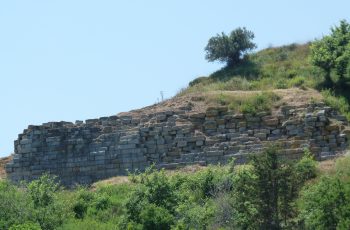Ancient Olynthus, extending over two natural hills east of the present-day village, evolved into the most important city in Chalkidiki. From 432 BC onwards, when the citizens of many coastal cities settled in the area and Olynthus became the capital of the Chalcidian League, it was a key economic and military center in the region until it was destroyed by...
Ancient Mende, one of the most important cities in Chalkidiki, south of present-day Calandra, was founded by Eretrians. Thanks to its extensive trade, its strategic location for maritime routes, timber export but mainly, the production and export of the highly regarded “Mendean wine”, the city experienced great economic prosperity. In addition, it was the homeland of Paeonius, 5th century BC...
Sane, an Andrian colony founded in the 7th century BC in the region of Nea Roda, and Ouranopolis or Ouranidon polis, founded in the late 4th century BC, are located on the Athos peninsula or Acte as it was called in antiquity. A sanctuary dating from the late Archaic to the Hellenistic period was excavated in the area: Apollo’s “house”...
The sanctuary of Poseidon in the area of ancient Mende was uncovered on the south coast of the sandy cape Poseidi. It is believed to be founded by Eretrian settlers, along with the city of Mende, as early as the 12th century BC. The remains of four buildings of worship were revealed, which were either adjacent or overlapping each other....
The basilica of Bishop Sophronios is an important early Christian monument, which is located east of Nikiti; it dates in the late 4th or early 5th century A.D. The church was built as a three-aisled, wooden-roofed basilica. In the apse of the sanctuary is preserved the synthronon with the bishop’s throne, while traces of the altar were also found.
The ancient city of Stagira is located northeast of Olympiada and is best known as the birthplace of the philosopher Aristotle. It extends over a small mountainous peninsula, currently named Liotopi. The ancient city was founded by Ionian colonists from Andros in the middle of the 7th century BC. It was destroyed by Philip II, king of Macedonia in 349,...
The sanctuary of Dionysus, probably also of the Nymphs, was founded by the Aphytians in Kallithea around the end of the 8th century, in a place favored by nature, with springs, lush vegetation and a cave. The inhabitants founded a sanctuary of Zeus Ammon northeast of the sanctuary of Dionysus in the first half of the 4th century BC and...
Torone was founded on the southwest end of the Sithonia peninsula by the Chalcidians of Euboea at the end of the 8th century BC and it was the largest city in the region. In 349 BC, the city was occupied by Philip II but it was not destroyed. Excavations by the Australian Archaeological Institute in collaboration with the Archaeological Society brought to...
During the 1995-1996 excavations, the foundation of a temple of the classical period which was probably dedicated to the goddess Athena was discovered, with dimensions 33.50m x 16.60m. Despite its fragmented preservation, it is striking that the carving of the foundation course which marked the different parts of the temple, pronaos, cella and opisthodomos, which are not preserved today, was...
Parts of the fortified enclosure and a retaining wall of the city were discovered at the sites of St. Demetrius, St. George, Alonia and Kastro. The first site is located on the slopes of the first hill of the settlement and probably constituted one of the gates, while the next two sites are located high up and are preserved in...
The excavation of Plot 28 was included in the Operational Program “Macedonia – Thrace (2007-2013)” of the Region of Central Macedonia, under the project “Protection and enhancement of part of the ancient cemetery of Acanthus in Chalkidiki”. It is the only plot within the confines of the seaside cemetery where burial activities and practices of the inhabitants of the ancient...
The cemetery of ancient Akanthos occupies an area of approximately 60 acres and it is in close proximity to the present-day settlement of Ierissos. The 13.200 burials identified during rescue excavations are divided in terms of space, type and chronology in two cemeteries: the inland cemetery, which dates back to the Iron Age, and the seaside cemetery, characterized by the...
It is an inscribed marble statue base, which introduces us to life in Akanthos during the Roman period.
The edifice, which dates back to the Hellenistic period, is most likely a public building with successive building phases arranged around a marble-paved atrium (courtyard) with two wells. The excavation of the building has not been completed, but the spaces and their use are clearly defined. Pottery from the Hellenistic period was discovered inside the wells, which places the end...
Zygou Monastery is located southeast of the current settlement of Ouranoupoli, in close proximity to the boundaries of Mount Athos. In 958, Athanasius the Athonite, founder of the Monastery of Megisti Lavra, visited the area of “Zygos” where he spent the first years of his ascetic life under the mentorship of an elder of the region. During the 11th century,...















